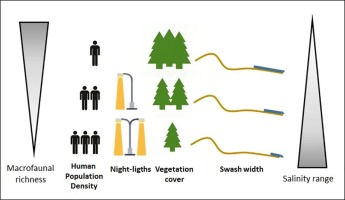Ecological Indicators ( IF 6.9 ) Pub Date : 2020-01-08 , DOI: 10.1016/j.ecolind.2019.106036 L. Orlando , L. Ortega , O. Defeo

|
The rapid urban population growth and coastal infrastructure development worldwide add dimensionality and complexity to the management process in sandy shores, and therefore the development of beach quality indices that take into account the increasing role of urbanization are particularly relevant. This work analyses the potential of human population density (HPD), nighttime lights and vegetation cover as indicators of urban impact on sandy beach biodiversity. Each indicator was tested against a large-scale 2-yr study of macrofaunal richness and physical characteristics along a strong environmental gradient defined by the widest estuary of the world, the Rio de la Plata. A negative linear relationship between HPD and the number of species was found. The amount of light recorded at night peaked at the most urbanized area in the coast, Montevideo city, and showed a negative relationship with macrofaunal richness. Vegetation cover, expressed through a normalized difference vegetation index, showed a weak positive relationship with species richness. Multiple linear regressions, combining urban indicators and physical characteristics as explanatory variables of macrofaunal richness, showed the best results when HPD and salinity range were combined. A regression tree explained 65% of deviance and had a structure coherent with previous results. Salinity was the dominant ecological driver: beaches with salinity ≥27.2 showed higher species richness, while beaches with less salinity and higher nighttime lights showed the lowest species richness. Random Forests selected salinity (mean and range) and HPD as the most informative variables to discriminate groups of beaches according to their macrobenthic richness. These results reflect that the salinity gradient is a macroscale driver that shapes species richness patterns along this coast, whereas the effects of urbanization are confined within the dominant large-scale environmental gradient. The identification of suitable urban indicators provided in this work constitutes the first step onto the development of more rigorous approaches to assess this globally relevant and long-lasting stressor.
中文翻译:

沿河口梯度的城市化对沙滩大型动物的影响
世界范围内城市人口的快速增长和沿海基础设施的发展为沙质海岸的管理过程增加了维度和复杂性,因此考虑到城市化的日益重要作用的海滩质量指标的发展尤为重要。这项工作分析了人口密度(HPD),夜间照明和植被覆盖的潜力,这些指标可作为城市对沙滩生物多样性影响的指标。每个指标都针对大型动物的丰富度和物理特征进行了为期两年的大规模研究,该研究沿着世界上最广阔的河口里约热内卢定义的强烈环境梯度进行。发现HPD与物种数量之间呈负线性关系。夜间记录的光量在沿海城市化程度最高的地区达到顶峰,蒙得维的亚市,与大动物的丰富度呈负相关。通过归一化差异植被指数表示的植被覆盖度与物种丰富度呈弱的正相关关系。结合城市指标和物理特征作为大型动物丰富度的解释变量的多元线性回归显示,当HPD和盐度范围相结合时,最佳结果。回归树解释了65%的偏差,并具有与先前结果一致的结构。盐度是主要的生态驱动因素:盐度≥27.2的海滩显示出较高的物种丰富度,而盐分较低且夜间照明较高的海滩则显示出最低的物种丰富度。随机森林选择盐度(平均值和范围)和HPD作为最有用的变量,根据其大型底栖动物的丰富度来区分海滩组。这些结果表明,盐度梯度是一个宏观驱动力,它决定了该海岸物种的丰富度模式,而城市化的影响则局限于主要的大规模环境梯度内。这项工作中提供的合适的城市指标的确定是开发更严格的方法来评估这种全球相关且持久的压力源的第一步。而城市化的影响仅限于主要的大规模环境梯度。这项工作中提供的合适的城市指标的确定是开发更严格的方法来评估这种全球相关且持久的压力源的第一步。而城市化的影响仅限于主要的大规模环境梯度。这项工作中提供的合适的城市指标的确定是开发更严格的方法来评估这种全球相关且持久的压力源的第一步。



























 京公网安备 11010802027423号
京公网安备 11010802027423号